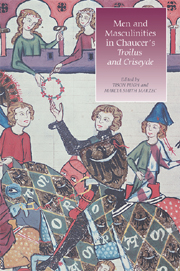Book contents
- Frontmatter
- Contents
- Contributors
- Abbreviations
- Introduction: The Myths of Masculinity in Chaucer's Troilus and Criseyde
- 1 “Beautiful as Troilus”: Richard II, Chaucer's Troilus, and Figures of (Un)Masculinity
- 2 The State of Exception and Sovereign Masculinity in Troilus and Criseyde
- 3 Revisiting Troilus's Faint
- 4 What Makes a Man? Troilus, Hector, and the Masculinities of Courtly love
- 5 Masculinity and Its Hydraulic Semiotics in Chaucer's Troilus and Criseyde
- 6 Masochism, Masculinity, and the Pleasures of Troilus
- 7 “The Dreams in Which I'm Dying”: Sublimation and Unstable Masculinities in Troilus and Criseyde
- 8 “A Mannes Game”: Criseyde's Masculinity in Troilus and Criseyde
- 9 Troilus's Gaze and the Collapse of Masculinity in Romance
- 10 Sutured Looks and Homoeroticism: Reading Troilus and Pandarus Cinematically
- 11 Being a Man in Piers Plowman and Troilus and Criseyde
- 12 “The Monstruosity in Love”: Sexual Division in Chaucer and Shakespeare
- Index
- CHAUCER STUDIES
5 - Masculinity and Its Hydraulic Semiotics in Chaucer's Troilus and Criseyde
Published online by Cambridge University Press: 12 September 2012
- Frontmatter
- Contents
- Contributors
- Abbreviations
- Introduction: The Myths of Masculinity in Chaucer's Troilus and Criseyde
- 1 “Beautiful as Troilus”: Richard II, Chaucer's Troilus, and Figures of (Un)Masculinity
- 2 The State of Exception and Sovereign Masculinity in Troilus and Criseyde
- 3 Revisiting Troilus's Faint
- 4 What Makes a Man? Troilus, Hector, and the Masculinities of Courtly love
- 5 Masculinity and Its Hydraulic Semiotics in Chaucer's Troilus and Criseyde
- 6 Masochism, Masculinity, and the Pleasures of Troilus
- 7 “The Dreams in Which I'm Dying”: Sublimation and Unstable Masculinities in Troilus and Criseyde
- 8 “A Mannes Game”: Criseyde's Masculinity in Troilus and Criseyde
- 9 Troilus's Gaze and the Collapse of Masculinity in Romance
- 10 Sutured Looks and Homoeroticism: Reading Troilus and Pandarus Cinematically
- 11 Being a Man in Piers Plowman and Troilus and Criseyde
- 12 “The Monstruosity in Love”: Sexual Division in Chaucer and Shakespeare
- Index
- CHAUCER STUDIES
Summary
In one of its grandest gestures of homage to the classical tradition of Ovidian love literature, Chaucer's Troilus and Criseyde fixes the early depiction of its protagonist on the act of writing – but it is an act strangely overdetermined. Following some initial coaching by Pandarus to write a letter that is decisive yet not too rhetorically overwrought, Troilus ends up attempting to authenticate his letter by spilling his tears on the exterior of the letter, rather than on the sealed-up lines of inscription constituting the letter's inner, i.e., communicational surface. Whereas Pandarus suggests that Troilus “biblotte” his script with “teris ek a lite” (2.1027), the hero instead “with his salte teris gan … bathe / The ruby in his signet, and it sette / Upon the wex deliveriche and rathe” (1.1086–88). Following the now conventionalized gender analysis of male suffering in the poem – louise Fradenburg's distinction, for instance, between the heroic nature of Chaucerian masculinity evidenced in immersion in violence coupled with public suffering and the nonheroic nature of Chaucerian femininity evidenced as mere survival – we can conclude that the altered or botched hydraulic scenario of the tears applied to the signet and in turn to the sealing wax signifies the occultation of male suffering. If male suffering is to be celebrated, made public, it must find clear expression in any number of readable and visible forms – not just in the pageantry of the histrionized, heroic self bedecked with wounds, arrows, and bashed-up armor, but precisely too in this situation concerning the staining of preexistent writing, making for a mutated, but still visible and readable writing of the body's internal and invisible suffering. The tear-blotted wax fails to do that, chalking up for Troilus yet another moment of deferred masculinity and, as gender-theorized or feminist criticism has often found, a kind of feminized status as a failed masculine romance hero.
- Type
- Chapter
- Information
- Publisher: Boydell & BrewerPrint publication year: 2008



